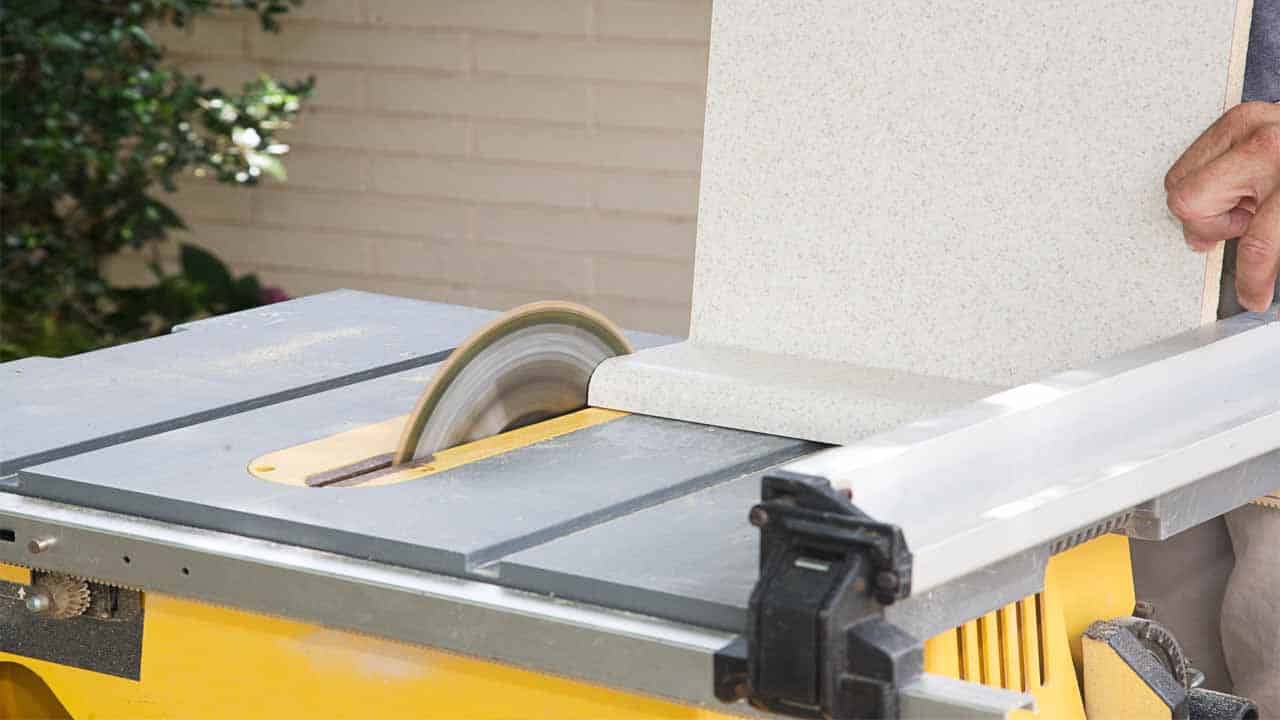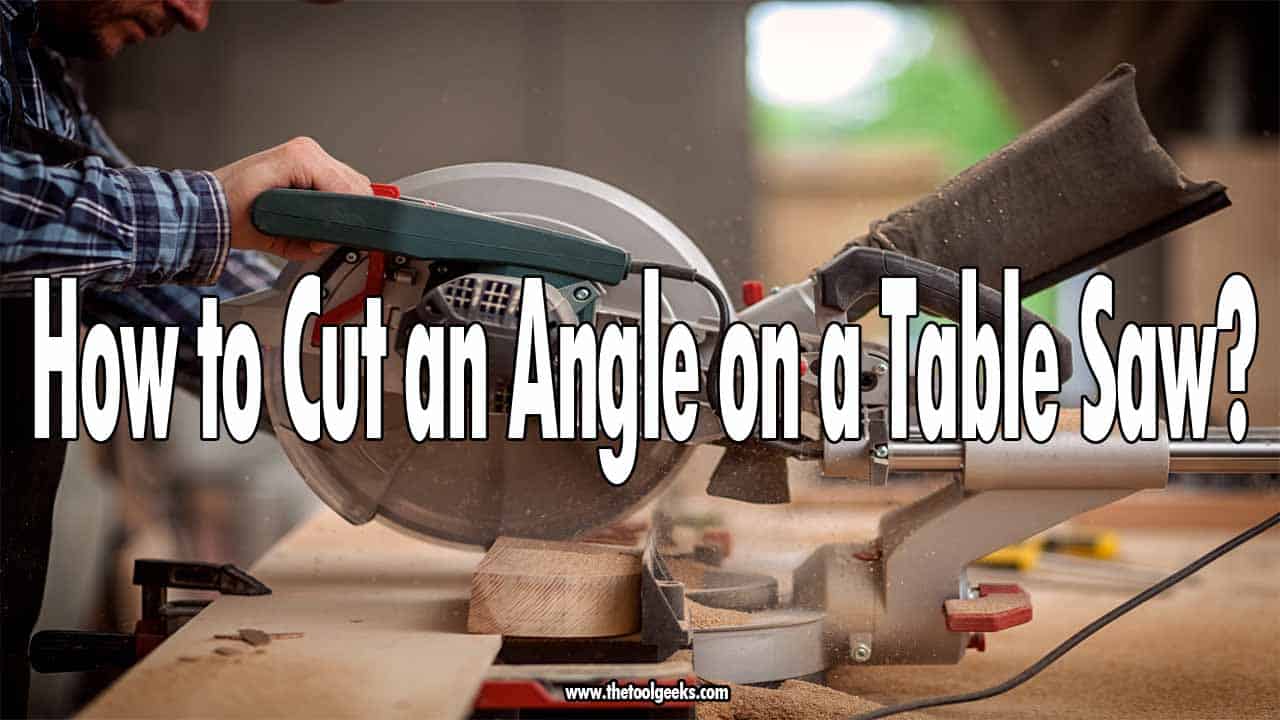How to Cut an Angle on a Table Saw (Improve Your Craft Skills)
TheToolGeeks.com is a participant in the Amazon Services LLC Associates Program and other affiliate advertising programs. We may earn from qualifying purchases. (Learn More).
Using a table saw to cut an angle on a piece of board is a relatively easy task that will give you consistent, quality cuts that need very little treatment afterward. The main problem that people tend to have is actually getting their angle set before making the cut – when you know how to do this, it’s really easy.
Although using a different type of saw (such as a bandsaw) might remove the time consuming, fiddly set up of this kind of cut, you won’t get the clean finish that you get with a table saw. Cutting down on cleaning uptime is key to running a successful business as it means you can get on with the next job right away. Your table saw can actually save you money.
Your table saw is your best friend with these kinds of jobs, especially if you can learn to set up your jig in the correct way quickly. All you need is a little bit of patience and a willingness to do a bit of trial and error.
Related Read —Best Table Saws for Inexperienced Woodworkers
Jump To Page Contents:
How to Cut an Angle on a Table Saw?
Gathering Your Equipment
Before you start any woodworking task, you need to know exactly what is necessary to make the cut. You don’t want to make half a cut, realize you’ve forgotten something, and have to return to the task later.

Repeated cuts and half-finished jobs make it more likely that you will make an error or damage the wood. Proper preparation will cut down on wasted time cleaning up a job and wasted materials.
Before you even think about turning on that table saw, make a checklist of all the necessary equipment and collect it. Taking time to do this at the beginning will saw time on cuts. This will also cut down on wasted materials in the long run!
You will need:
- Table saw
- A fence that fits onto the table saw
- Pen / pencil
- Ruler
- Adjustable jig (sometimes called a taper guide)
- Safety equipment such as goggles and ear protectors
For the sake of this article, we will refer to the jig as a jig.
Safety First
Table saws are powerful pieces of equipment. They can also be very dangerous when in the wrong hands. They are literally tables with a spinning saw sticking upwards towards the woodworker.
Taking time to make sure your workspace is safe is very important. Although you don’t need to move very much when using a table saw, you should still clean your workspace and store all equipment safely. This includes putting cabling tidily away so that no one will trip on it, including you.
As a woodworker, your hands and eyes are your career. Take care of them and they’ll take care of you. Table saws can spit wooden splinters and chips back at the user during a cut, so wearing eye protection saves the user from potential injury. You can find good quality goggles in any decent DIY or hardware shop, generally for low prices. There’s no excuse for not having a pair.
You will also want to put in ear protection. Your ears are sensitive to loud noises. Long term exposure can lead to significant hearing damage, which will affect you the most in later life. Save your eardrums and get some good quality earbuds or earphones.
When using a table saw, you want to keep your hands away from the blade (obviously). To make sure that they won’t be pulled towards the blade, avoid wearing long-sleeve or baggy shirts.
These can get caught in the mechanism, potentially leading to serious injury. If you want to be extremely safety conscious, getting a push stick to feed the wood through the saw may also be a good idea for you.
Related Read — Best Sliding Table Saws
Setting Up Your Table Saw
Before we put the board onto the table saw, use a pen or pencil to draw the angle of the cut. This line will make it easier to check if you are staying on the right line for the cut, as well as help you set the jig correctly. Whereas you might be able to get away without drawing a line with some jobs, you need one for this.
Next, we need to set up our table. Plug-in the saw and make sure that power is flowing to it. Also, check that the power lead is not underneath your feet. If you need to move during the cut and your feet get tangled, serious injury could be a serious outcome. Remember, safety first.
Now that your board is marked, place the jig on the table so that it lines up with the fence. Setting the jig is going to be the tricky part.
Setting Up Your Jig
There are millions of kinds of jigs. We want one that is adjustable; the two arms should be able to fan out and give you an accurate angle. We don’t need to have a specific angle set; we can work this out with our ruler method. You want the jig to be able to move to an angle that helps us line up the pen mark on our board with the line of the saw.
Line the board up with the jig. The right-hand side of the jig should stay tight to the fence. If your jig is open, the board should be on an angle. You might get lucky here, but you will probably have to adjust your jig so that your board lines up correctly.
Use a Ruler
Using a ruler, you need to check two measurements. From the top of the line on the board to the top of the jig and from the bottom of the line on the board to the top of the jig. If you haven’t set up your jig, these numbers will probably be different. You need to adjust the angle so that the two measurements are the same.
The adjustment is a trial and error process – you will need to do this until the angles match up. If they do not match, then you will not get an accurate cut. Inaccurate cuts lead to wasted time, money, and resources. Spend a little time now and save it when you need to fix up your product.
Related Read — Table Saw or Track Saw?
Check The Line
Now you need to do a line of sight check from the board’s pencil line to the line of the saw blade. If you really want, you can use a ruler to check they line up cleanly. I would just move the jig and board towards the blade without applying any power to the table saw.
When the board and the jig are set at the correct angle, you will notice that the line should match up with the blade. If it is, perfect! You are ready to make the cut. If it’s not, circle back to the start of this section and adjust your jig. Measure, adjust, measure, adjust. This is a trial and error task!
Administering the Cut
Now that the board is set up correctly, you can begin to feed the wood towards the saw blade. Start your blade spinning before the board reaches it; if your blade is still speeding up when you start to make the cut, the slow speed can cause chipping and splintering. Clean cuts need fast blades.
Double-check for safety and get ready to slide your board forward. Plan to feed the entire block through the saw in one go.
You want your jig and your board to move together. If they don’t, you wasted your time setting the jig up. The correct hand position for making this cut is the right hand on the jig and the left hand on the outside of the board. Your jig hand should be tight to the fence to make sure that no fingers going near the spinning teeth of your table saw.
Related Read — Table Saw 101: How to Cut Plywood?
Feed The Wood Towards The Blade
Next, you just want to feed that wood towards the blade. This should be smooth, steady, and done in one motion. You don’t want to stop and start this job as the teeth on your table saw can “drag” against the board when it spins slowly. Slow spinning blades can potentially ruin any job, especially with thin pieces of wood.
If you have fed your wood through in the appropriate way, you will have a nice clean cut on your wood. Job done. You have a clean, angled cut on your board with only a little bit of set up. You may have some minor sanding or cleaning to do, but the table saw is pretty reliable when it comes to getting clean cuts and excellent finishes.
The main strength of the table saw cut is that it is clean. You will have very little aftercare to do with this board, meaning that you can move onto your next project straight away. Just like when we were setting up, make sure you pack your equipment away safely. The table saw should also be turned off. Remember, safety first.
Conclusion
Making an angled cut with a table saw is a simple process, but you need to take time to set it up correctly. This involves setting up your table saw so that it is working properly, setting up your jig to the correct angle, and following the pencil line on your board.
If getting a clean and accurate cut is important to you (and it should be), the table saw is an excellent choice for an angled cut. Table saws can be difficult to move around, so make sure you know the exact angles you need before heading back to your workshop from a site.
Using a table saw needs a great deal of respect – you need to understand that this is a spinning blade that is staring you in the face. Calm, steady, and smooth approaches to the table saw will saw you a lot
Related Read — Table Saw vs Radial Arm Saw
FAQs About Making a Curved Cut with a Table Saw
Can a Table Saw Cut Angles?
Yes, but you will need a jig. By using a jig, you effectively change the angle of the fence. This changed angle lets you feed the wood in at a different angle, meaning you get the perfect angled finish. Table saws are also excellent at angled cuts as they’re cleaner than some of the equipment you might use, like a bandsaw.
Related Read — Table Saw or Miter Saw?
Is It Difficult to Cut Angles With a Table Saw?
No, especially if you know what you’re doing. You will need to use a jig to secure the angle and make sure you know how to feed the board through the saw when using a jig. This does require you to do a little trial and error, but it’s not a difficult task at all.
Can You Make a 45-degree Angle Cut With a Table Saw?
Table saws can easily make crosscuts (cuts at 45 degrees). However, you don’t need a jig for that and can simply feed the wood into the blade sideways. Using an extension fence can make this process easier.
Can You Make a 70-degree Angle Cut With a Table Saw?
Yes, you can. Draw your line on the board. Then set up your jig so that the top and bottom of the line on your board are equal distances from the fence. Now you can feed the board through the table saw and you will get an excellent finish.
Why Should I Use a Table Saw for an Angled Cut?
Table saws offer excellent precision and efficiency. The boards you cut need very little aftercare when the job is done. This is the main strength it has over the bandsaw; even though the bandsaw may take less set up time, you will have to clean the edges of the cut.
Is It Safe to Use a Table Saw for an Angled Cut?
As safe as the woodworker using it. If you always remember safety first, you will be able to cut wood without any issues. Remember, goggles, ear protection, fingers don’t need blades. If you can follow that, you will do just fine.
Amazon and the Amazon logo are trademarks of Amazon.com, Inc, or its affiliates.

